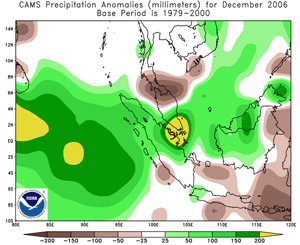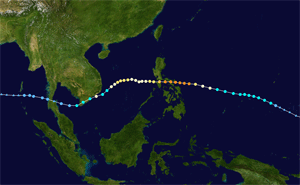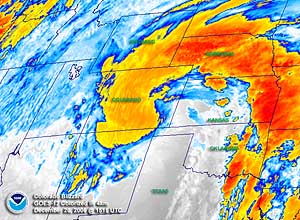Global Analysis / Global Hazards / United States / U.S.
Drought / Extremes
Use these links to access detailed analyses of Global and U.S. data.

 Drought & Heat | Flooding | Storms | Tropical Cyclones | Extratropical Cyclones | Severe Winter Weather
Drought & Heat | Flooding | Storms | Tropical Cyclones | Extratropical Cyclones | Severe Winter Weather


Across the United States, significant drought affected areas of the Plains and Rocky Mountains. Extreme drought was also concentrated in northern areas of Minnesota, parts of Wyoming and Nebraska, as well as sections of Texas and Oklahoma. |
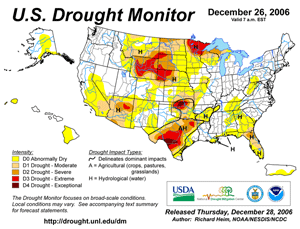
U.S. Drought Monitor
|


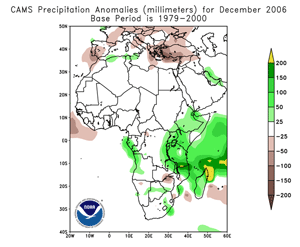
African Rainfall Anomalies
|
Heavy rainfall that began in October 2006 across the Horn of Africa continued into early December. Flooding in areas of Somalia, Ethiopia and Kenya impacted hundreds of thousands of people (IFRC). In Kenya alone, the number of affected people was estimated at 723,000 (OCHA).
|
In Haiti, heavy rainfall in late November and early December in the western part of the country washed away roads and bridges, wiped out crops and killed at least three people (Associated Press).
|
In Indonesia, two days of heavy rain prompted a landslide in Solok regency, West Sumatra on the 16th. There were eighteen deaths as a result of the landslide (Jakarta Post).
|
During the last ten days of December, heavy rains in Indonesia's Aceh province produced severe flooding that displaced 127,000 people. There were 126 deaths on Sumatra island, with 76 of the fatalities occurring in Aceh province (Associated Press/UN-WFP). |
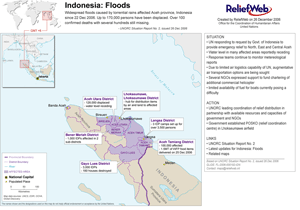
Indonesia Flooding
|
Heavy rainfall in southern Malaysia forced the evacuation of around 59,000 people by mid-to-late December 2006. There were at least 12 fatalities (AFP).
|


In the United Kingdom, a tornado struck northwest London on the 7th, damaging several homes and injuring at least 6 people. On average, about 33 tornadoes are reported annually in Britain (Associated Press).
|
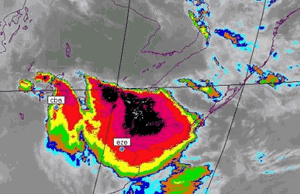
Satellite Image Of Thunderstorms In Uruguay
|
Severe thunderstorms, including tornadoes, impacted portions of
Argentina, Uruguay and southern Brazil during December 17-21. There were at least thirteen deaths in Argentina, two in Uruguay and one in Brazil (MetSul Meteorologica).
|
In the United States, severe thunderstorms produced four tornadoes on Christmas Day in Florida. Columbia, Pasco, Lake and Volusia counties were hardest-hit, including the Daytona Beach area. A tornado generated considerable damage on the campus of Embry-Riddle Aeronautical University (see photo right), delaying the start of the spring semester (Orlando Business Journal). |
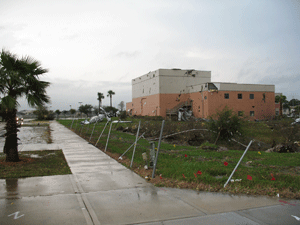
Florida Tornado Damage
|


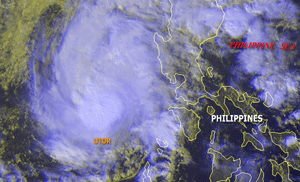
Typhoon Utor
|
Typhoon Utor developed in the Philippine Sea on the 7th, reaching typhoon strength by the 9th. Utor crossed the central Philippines during the 9th with maximum sustained winds estimated near 140 km/hr (75 knots or 85 mph). It was the fifth typhoon since September to impact the Philippines. There were four fatalities (Reuters).
|
Tropical Cyclone Bondo developed in the southern Indian Ocean on the 18th, and reached the coast of Madagascar near Mahajanga as a tropical storm on the 25th. Maximum sustained winds at the time of landfall were near 115 km/hr (60 knots or 70 mph). The primary impact was heavy rainfall across northern Madagascar. |
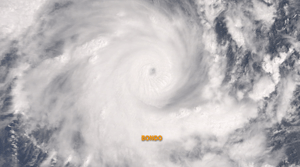
Tropical Cyclone Bondo
|


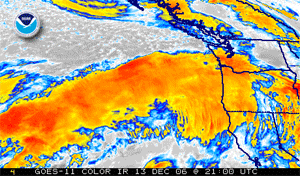
U.S. Northwest Storm (large ~9MB animation)
|
A powerful storm system that slammed into the U.S. Pacific Northwest during December 13-15 produced strong winds, heavy rainfall and higher elevation snow. Hurricane-force wind gusts caused power outages that affected 1.5 million homes across Washington and Oregon. There were 4 fatalities (Associated Press).
|


A parade of Pacific storm systems brought heavy snow to mountainous regions of the U.S. Pacific Northwest and adjacent areas of Canada during December 2006. Several feet of snow had accumulated in some parts of the Cascade Mountains by mid-month. |
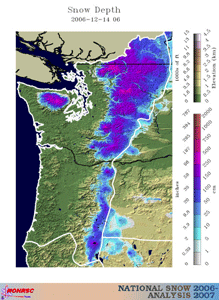
Pacific Northwest Snow Cover
|

For all climate questions other than questions concerning this report,
please contact the National Climatic Data Center's Climate Services
Division:
- Climate Services Division
NOAA/National Climatic Data Center
151 Patton Avenue, Room 120
Asheville, NC 28801-5001
fax: 828-271-4876
phone: 828-271-4800
email: ncdc.orders@noaa.gov
|

For further information on the historical climate perspective presented in this report, contact:
- Scott Stephens
NOAA/National Climatic Data Center
151 Patton Avenue
Asheville, NC 28801-5001
fax: 828-271-4328
email: Scott.Stephens@noaa.gov
|
|




